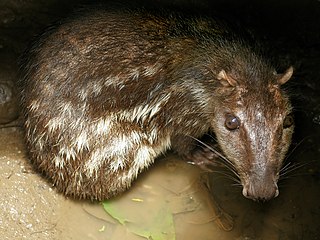
Dasyproctidae is a family of large South American rodents, comprising the agoutis and acouchis. Their fur is a reddish or dark colour above, with a paler underside. They are herbivorous, often feeding on ripe fruit that falls from trees. They live in burrows, and, like squirrels, will bury some of their food for later use.

The lowland paca, also known as the spotted paca, is a large rodent found in tropical and sub-tropical America, from east-central Mexico to northern Argentina, and has been introduced to Cuba and Algeria.

The agouti or common agouti is many of several rodent species of the genus Dasyprocta. They are native to Central America, northern and central South America, and the southern Lesser Antilles. Some species have also been introduced elsewhere in the West Indies. They are related to guinea pigs and look quite similar, but they are larger and have longer legs. The species vary considerably in colour, being brown, reddish, dull orange, greyish, or blackish, but typically with lighter underparts. Their bodies are covered with coarse hair, which is raised when alarmed. They weigh 2.4–6 kg (5.3–13.2 lb) and are 40.5–76 cm (15.9–29.9 in) in length, with short, hairless tails.

Osmunda regalis, or royal fern, is a species of deciduous fern, native to Europe, Africa and Asia, growing in woodland bogs and on the banks of streams. The species is sometimes known as flowering fern due to the appearance of its fertile fronds.

The crested porcupine, also known as the African crested porcupine, is a species of rodent in the family Hystricidae native to Italy, North Africa and sub-Saharan Africa.

The black agouti is a South American species of agouti from the family Dasyproctidae.

The red-rumped agouti, also known as the golden-rumped agouti, orange-rumped agouti or Brazilian agouti, is a species of agouti from the family Dasyproctidae.

Azara's agouti is an agouti species from the family Dasyproctidae. Found in Brazil, Paraguay, and Argentina, it is named after Spanish naturalist Félix de Azara. The population is unknown and may have gone locally extinct in some areas due to hunting; it is listed as vulnerable in Argentina.

The black-rumped agouti is an agouti species from the family Dasyproctidae. It is endemic to Brazil, and its range roughly equals the Northeast Region. It is named after its black rump which contrasts clearly with the orange body.

The Central American agouti is a species of agouti from the family Dasyproctidae. The main portion of its range is from Chiapas and the Yucatan Peninsula, through Central America, to northwestern Ecuador, Colombia and far western Venezuela. A highly disjunct population is found in southeastern Peru, far southwestern Brazil, Bolivia, western Paraguay and far northwestern Argentina. The disjunct population has been treated as a separate species, the brown agouti, but a major review of the geographic variation is necessary. The Central American agouti has also been introduced to Cuba and the Cayman Islands.

The crested servaline genet, also known as the crested genet, is a genet species endemic to Nigeria and Cameroon. As the population has declined due to loss of habitat, it is listed as Vulnerable on the IUCN Red List. It was first recorded in the Mamfe Division in Cameroon and initially considered a subspecies of the servaline genet. But now it is regarded as a distinct species.

The kinglet calyptura is a small passerine bird. It is the only member of the genus Calyptura in the family Tyrannidae. It had traditionally been considered a member of the family Cotingidae. It is endemic to Atlantic forest in south-eastern Brazil. For a long time this species was feared to be extinct, as it went unrecorded during the 20th century until two birds were observed in Serra dos Órgãos on several days in October 1996. Since these sightings, there have not been any confirmed records, although at least one recent—but unconfirmed—record exists from near Ubatuba. Consequently, it is considered Critically Endangered by BirdLife International.

The Coiban agouti is a species of rodent in the family Dasyproctidae. It is endemic to the island of Coiba (Panama) and resembles the more widespread Central American agouti. It is threatened by habitat loss.
The Orinoco agouti is a species of rodent in the family Dasyproctidae. It is endemic to Delta Amacuro in Venezuela, where it is found in areas with rainforest or mangroves.
Kalinowski's agouti is a species of rodent in the family Dasyproctidae. It is endemic to southeast Peru. It occurs at elevations of up to 3,080 metres (10,100 ft) asl. It is threatened by habitat loss.

The Mexican agouti,, also known as the Mexican black agouti, is a species of rodent in the genus Dasyprocta. This species was first discovered in 1860 in Veracruz, Mexico and described by Henri Louis Frédéric de Saussure.

The Ruatan Island agouti, also called the Roatán Island agouti, is a species of agouti in the family Dasyproctidae. It is endemic to the island of Roatán, off the north coast of Honduras.
Cerradomys scotti, also known as Lindbergh's oryzomys, is a rodent species from South America in the genus Cerradomys. It is terrestrial and is found in the cerrado (savanna) ecozone of south central Brazil, Bolivia and Paraguay. The species is common and appears to tolerate a degree of agricultural habitat modification.














